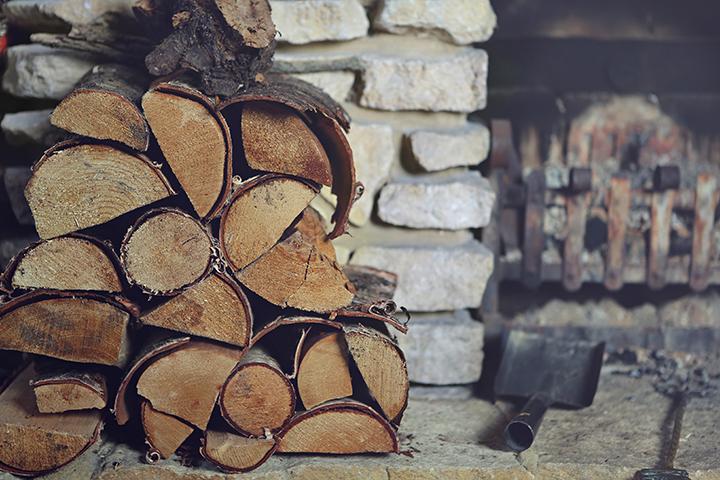|
|||
| Issue #90 • November/December, 2004 |
The first chore I remember seriously hating was carrying wood for the stove. Every day after school it took a minimum of 12 armloads to feed that thing until the next day. My sister was assigned to open and close the door as I came through and she was very bad at that job, especially if she was in a “mood.” Much of my summer was taken up in the wood lot gathering and cutting firewood with my father and a neighbor. During my teenage years tending the fire took time away from doing homework (not so bad) or talking on the phone with girls (very bad) so I had good reasons to figure out better ways to heat with wood when I started designing and building alternative homes.
The first step toward better wood heating is more respect for the trees sacrificed for our warmth by getting the most use from each one. The usual harvest method is to down the tree, remove all the limbs, and cut the trunk into lengths that fit in the stove. All those limbs and the treetops have a lot of stored BTUs that could be heating your home rather than decaying into forest fertilizer.
Build a lightweight rack from 2x4s and take it to the wood lot. Haul the limbs to it, pile them in and cut them to stove length with your chainsaw quickly and easily. Do this near your truck so it is easy to toss them in with the rest of the firewood. A good mix of sizes in your woodpile means easier fire starting in the stove and less need to split big pieces into kindling. I also take along a pair of limb loppers to cut off twigs and branches that are too small to burn. If I were a perfectionist I would bring a small wood chipper to turn them and the leaves into mulch. We do have one of those and I promise to use it this way someday. My estimate is that you will get 10 to 15 percent more firewood from each tree by processing the limbs.
I have been cutting some of my firewood from the wooded part of our land. Using more of the tree keeps the area cleaner and easier to “park out” later. If you live in an area where firewood is scarce you may be able to harvest your wood from residential properties if you promise to clean up after yourself. Maybe you could even charge money. So, this method could gain you firewood and money plus mulch. It is a good thing.
Fire bags for free
Another good thing is to make what I call fire bags. In my shop I sweep all the shavings, sawdust, and scrap wood under my work table. When I have trouble standing close to it, I half-fill bags (paper or plastic) with this debris using a dustpan. Tie or crunch the bags shut, pack them in cardboard boxes, and store the boxes near, or in, your wood box. A wood chipper could chop up dry twigs left from cutting firewood to also fill these bags. A little newspaper, a little kindling, and a fire bag with larger wood on top get a fire up and running quickly. Since these heating systems I describe do not burn continuously, starting new fires should be as convenient as possible.
An old truck tire can save labor and your back
Here is a work and back saver for you. If you are splitting your wood with a maul…well, you have my sympathies. To make this job a little easier stand the pieces of wood in the center hole of an old rubber tire and just hack away until they are the size you want. A big old Firestone truck tire holds plenty of pieces. I prefer Goodyear, but any brand will give you good maulage.
Sensible wood storage saves you labor
Once you have your firewood back home, split and piled in a woodshed, or at least covered to keep it dry while it seasons, it is time to streamline the job of getting the wood to the stove.
|
Build a wood storage box onto your house that loads from outdoors and is unloaded from indoors and located as near the stove as possible. It should have volume enough to hold a week’s worth of firewood at least, more if possible. Imagine it as a closet that opens indoors and outdoors. I have built these in existing homes by using a coat closet, commonly located near the front door, and adding an outside door to it. This makes a wood box about four feet by two and a half feet by about seven feet high which is a good size for a regular house and doesn’t alter the look of the home too much. I have also built wood boxes where a window was located by making the window into a door and building the storage chamber onto the outside, or inside, of the house. Some were built by just cutting through a wall in a convenient location between wall studs and adding the outside chamber. Weather-strip the interior door and seal all seams inside the box with caulk or duct tape to avoid bug migration. Put a screened vent in the outer door to allow the wood to dissipate moisture. Keep the wood box empty and clean during summer. Add locks on the inner door as a security measure and on the outer door if you need a jail cell.
Wood storage can be built in the cellar by replacing a basement window with a cover and adding a chute that empties into a chamber you build down there. Just remember to make the chamber very tight with a weather-stripped door to prevent drafts and bugs from entering your home. Be sure to ventilate the chamber to the outdoors. Less than completely seasoned wood can generate conditions where mold and other unpleasantness develop, so let that moisture out.
A big wood storage chamber needs to be refilled less often, allowing you the option of doing refills on fair weather days. Having a through-the-wall wood box avoids tracking in mud and debris, banging up woodwork, and letting cold air into your living space. If your woodpile is a distance from the house use a cart or wheelbarrow to transport it. Our wood box holds exactly a cord of wood. It takes two of us 45 minutes to load it up. We do this four times (five in very long cold winters) each season.
A fresh air inlet makes a fire more efficient
Now that the wood gathering method is worked out let’s look at some ways to improve the performance of your heating system. The average woodstove operates at only about 30% efficiency. That means 70% of the wood you collected and the work you did go right up the chimney. The more efficient stove designs bring efficiency up to about 65 percent but I want to tell you some ways to gain even more.
A woodstove doing its job uses all the air in a room about three times per hour. This is air already warmed by the heat from the stove and it will be replaced by air from outside the room, eventually from outside the home, whether you like it or not. Add to that the insult of knowing warmed air is going right up the chimney.
To get a big gain in efficiency build an air passageway from outdoors directly to the air intake on your stove. Make it as leak proof and tight as you can. Use stovepipe and/or flexible tubing of appropriate size, most likely four to six inches in diameter. Screen the intake hole to keep out little living things and build a damper in it to close off airflow to the stove when the fire is out. A basement or crawl space is a good location to route the pipe but be sure the pipe, which will be cold, won’t cause problems with water pipes. Insulating around it may be necessary.
|
You will be surprised by how much warmer your home feels after making this change. There is also a safety bonus. A back draft coming down the chimney as the stove cools passes out the pipe, not into your living space. This is a project within the capabilities of most homestead tinkerers and gives very satisfying results.
Another reason stoves do not operate more efficiently is the damping down of the fire. This is done to let heat be given off gradually over time by slowly burning the fuel. The trouble with this idea is that the lower heat fails to combust all the components of the firewood. This creates creosote and dirty smoke. On the other hand, if the fire is allowed to burn as hot as possible it would not last long, would overheat the room and could melt things nearby or set the cat on fire. There is another way.
Heat sinks allow cleaner fires and they store heat
The fire burns more efficiently, cleaner, and completely if it has all the air it wants. That leaves the problem of what to do with all that heat created in so short a time. What is needed is a “heat sink,” a mass of something that absorbs the heat quickly, then gives it off slowly. There are heating systems that do this. Stoves built inside a tank of water, sand, or another medium are available but expensive, and they need complicated installations. Don’t dismiss these systems without investigating their use if you are in a financial position to install one. Usually located outside your home, they keep all the disagreeable aspects of fossil fuel burning out of your home environment.
For now let’s get back to the financially challenged method of improving wood heat efficiency. Go out into nature and collect rocks, pretty rocks that are clean and stack nicely. Build a wall of stone against your stove and pile stones on top of it, being careful not to overload it or the floor underneath. Leave the door accessible. Granite is the best type of rock but other kinds work well too. The stones heat up quickly and radiate warmth slowly for many hours in a comfortable temperature range long after the fire is out. The wood fuel has burned most efficiently and the chimney stays cleaner.
For this plan to work appreciably you need at least a half-ton of stone shrouding your stove. Not much when you consider granite weighs about 160 pounds per cubic foot. If you have strong floors or are on a slab foundation, the more rocks the better. You can collect the stone over time and stop when you have determined, through experience, that you have enough to keep the room, or home, comfortably warm between stove firings. Be sure the chimney of your stove is clean and in good condition because the hotter fire increases the operating temperature of the chimney. A chimney fire, though very entertaining, is not a good experience.
There are more benefits to this idea. Although the stones get very warm they do not reach the skin sizzling temperatures that metal stove surfaces do. This helps prevent accidental burns and keeps flammable things (like wet mittens left to dry) away from harm. A kettle of water, soup, or what have you stays warm without boiling on the stones or nested into a niche made for that purpose. If you sleep in a cold bedroom, a warm stone wrapped in a towel is a welcome bed companion down by your feet. Humidity can be added to the air by sprinkling water over the stonesjust like in a sauna, only less intense. Be careful because very hot stones can fracture (sometime violently) if cold water is dumped on them. Careful sprinkling of plain water on the rocks gives off a wonderful aroma that is hard to describe. Of course you can use scents of your own. A metal pan with mint leaves, evergreen, or juniper needles roasting in it is really nice. Use your imagination.
A low-priced stove for my old Maine cabin
Up to now I have assumed you already have a woodstove. If you are lucky enough to be between stoves, here is a very efficient and low priced heating system I built years ago when I was living in a poorly insulated cabin in the Maine woods. I laid a 6 by 6-foot piece of six-mil plastic on the floor where I wanted my heater. Then I nailed together a 12-inch high, 6-foot square box made of 2×12 dimension lumber on top of the plastic. I filled the box nearly to the top with gravel. Nested into the gravel was a 55-gallon drum with a heater kit (stove door and chimney collar available at hardware stores or by mail order) and nice big rounded granite stones piled all over it. The drum accepts pieces of firewood up to three feet long. The hot fire allows the use of usually inferior types of fuel such as unseasoned and softwoods, when mixed with seasoned firewood.
|
The winter before I had to come home to a cold cabin with frozen water and an hour of warming up before I could take off my coat, then face the thought of a cold morning to follow. I cannot tell you how nice it was to come home from work to a warm cabin without the worry of leaving an unattended fire while I was away. Only an evening fire was needed to recharge the system for 24 hours or more. It made “roughing it” almost plush. I learned to cook meat on the coals in this heater. We do it now in our furnace for old times’ sake and because it does such a good job.
A heater like this, with the addition of ductwork bringing outside air directly into the combustion chamber, is efficient, safe, and strangely beautiful. It looks like a rock garden in your home and the warmth radiated from it gives you a very cozy feeling. In late spring I disassembled the whole conglomeration and stored the parts outside to make more room in my small cabin.
Making a “Big Daddy” for a bigger house
What I have just described is the basic heater system for a small home, cottage, or workshop. If your needs are greater you can set up two systems. Feng Shui guided builders should place their heater in the Center of their Bagua building map for Chinese scientific reasons.
In my Maine woods cabin I eventually turned my heater into a sauna room complete with a drum of water heated by a copper tube wrapped around the chimney. The tank was positioned near the ceiling, high enough to let me take showers, and added to the heat storage and radiating capacity of the system. Backwoods living can be extraordinarily pleasant. But I digress.
If you have a basement you could make use of Big Daddy. This is the same plan but it uses a 250-gallon (former) oil tank surrounded by concrete blocks (easier to stack) filled with small stones and rocks. The heat storage potential is very high and long lasting; one firing produces heat for days. Located in a cellar, the rising warmth keeps the home very cozy. This size heater needs a large heat sink. Ten to twelve tons of masonry and stone are not too much. You may have to call in a few favors and supply refreshments to get all that heavy stuff carted into your basement, but it is worth it.
Big Daddy can take five-foot logs if you are muscular enough to throw them in. The regular stove kit works on this size tank but a bigger door is a plus if you can find and install one. Fill the first 12 inches inside the big tank with sand for ballast and even more heat storage.
A six-inch stovepipe is the right size flue for any of these heaters. Install a chimney damper as you would with a regular stove. In this system the damper is not used to slow the draft but rather for closing the flue while the fire is out to prevent heat loss up the chimney. I bolt a piece of metal onto the commercial damper to make a better seal when it is closed. The piece you had to cut out of the tank or drum to accommodate the chimney collar works well. Don’t forget to build an air supply duct from outdoors directly into the heater with its own damper. When the fire is out (which, with Big Daddy, is most of the time), closing the intake and exhaust dampers stops heat loss up the chimney.
While building any of these heaters it is important to have the first fire, after assembling the metal work, out of doors. The original paint must be burned off and it is a good idea to give the cleaned metal heater a coat of high temperature paint and a second outdoor burn to cure it.
Back in the house, after the paint has cured, set the big tank up on the legs usually attached to it or on concrete blocks. Carefully pile blocks and stones around the tank in such a way that the pile is very stable. Don’t use mortar. The air spaces provide circulating passages for the hot air coming off the heater. If you are really clever, pile the block and stone in such a way that the tank is very close but not actually touching them. This will make replacing the tank easier when and if the time comes to do that.
Since Big Daddy is in the basement and you probably want the heat upstairs, here is a way to do that. Build a wall around the whole heater system to contain the warmth. Install a floor register above the furnace, allowing heat to rise through the floor into the living quarters. Or build a ducting system above the furnace that sends warmth to several upstairs rooms. Or tap into the existing heat duct system if you have one.
The surrounding wall must not be near enough to the metal parts of the heater to be a fire danger. A two-foot thick heat sink mass of concrete block and stone around the heater should shield the wall from danger. You can use plywood or drywall for this surrounding wall but the best material is insulation board with foil facing. It insulates well, is lightweight, and easy to build with good old duct tape.
|
All this wall and ductwork business probably won’t be necessary. Just leave the cellar door open and heat will rise into the house. A floor register or two that allows heat to rise into several rooms could be all you need.
If you have a damp basement then those days are over. Even with a dirt floor down there this heating system will dry it out. If it is really wet you may have to let the combustion air enter the heater from the basement for a while instead of from outdoors, but Big Daddy destroys dampness.
Attach the stovepipe to a safe chimney and have a small first fire to dry out the blocks and stones. I do this on a day when the house windows can be open because there may still be some paint odor. Gradually increase the size and duration of the fires to begin discovering the benefits of this heating system.
It is a good idea to have your first fire of the winter season on a day when you can ventilate the house. Over summer, dust accumulates on the heater and stones (plus I usually spray a thin coat of WD-40 on the metal in the spring) and this must be burned away, sometimes giving off odors.
Maintenance
During the off-season remove the ashes and spray old motor oil on the inside walls of the heater. This will ward off rust, the archenemy of all metal. The heat produced in the big tank may warp its walls but this does not hurt the efficiency. Changing a big tank heater takes me about eight hours’ work removing the old one, assembling the stove kit onto the next tank, and installing it. I find all the tanks I need at a scrap metal yard. Some tanks have heavier gauge metal than others. Get the heavier one.
You will need a saber saw, an electric drill, and some hand tools to assemble these heaters. Beyond that, your ability to lug and pile rocks and blocks is the most important contribution to the project. What you have is a heating system much more efficient than a regular one plus it is easy to build and maintain at a minimal cost and it uses no electricity.
Other metal containers could be used for wood heaters. I once tried a large propane tank. It had thicker steel and was a good size but the drill and saber saw had all they could do to cut it and the rounded surfaces created problems making a door for it. The 55 and 250-gallon tanks are easy to obtain, easy to work with, and transfer heat quickly. Keep rust away from them and they last many years.
Next issue I’ll tell you how to build an interesting chimney to extract even more heat from your firewood, and it does other unexpected things. I usually say that home building does not require rocket science but this chimney project actually does use some. The chimney, matched up with the heaters in this article, may convince you that wood heating should be the basic system in your home, and the others considered part-time alternatives.


















